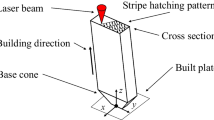Abstract
Lapping ceramic balls with variable-radius groove plate (VRGP) has obvious advantages in achieving good consistency of batch manufacturing of ceramic balls. The material removal model of a single ball was established based on Hertz contact theory. Then, combining the previous research works based on kinematic analysis and the material removal model, the forming process of single ball was simulated and evaluated by the deviation from spherical form (∆Sph). After lapping period of 10 h, the experimental deviation ∆Sph decreased from about 0.233 to 0.0324 μm, and its maximum error between experimental and simulation values is 17.7%, indicating that the simulation results of variation of ∆Sph with time were mostly consistent with the experimental results. The validity of material removal model of lapping ceramic balls was verified experimentally.















Similar content being viewed by others
References
Zaretsky E, Vlcek B, Hendricks R (2005) Effect of silicon nitride balls and rollers on rolling bearing life. Tribol Trans 48(3):425–435
Lu D, Zhao W, Lu B, Zhang J (2014) Effects of rolling bearing type and size on the maximum eccentricity ratio of hydrodynamic rolling hybrid bearings[J]. Tribol Trans 57(2):225–229
Umehara N, Kato K (1996) Magnetic fluid grinding of advanced ceramic balls. Wear 200:148–153
Umehara N, Kirtanea T, Gerlicka R, Jainc V, Komanduria R (2006) A new apparatus for finishing large size/large batch silicon nitride (Si3N4) balls for hybrid bearing applications by magnetic float polishing (MFP). Int J Mach Tools Manuf 46:151–169
Zhang B, Uematsu T, Nakajima A (1998) High efficiency and precision grinding of Si3N4 ceramic balls aided with magnetic fluid support by using diamond wheels. JSME Int J Ser C 41(3):499–505
Ma W, Zhang B, Nakajima A, Mawatari T (2015) Electrolytic in-process dressing grinding of ceramic balls. Int J Adv Manuf Technol 79:1153–1160
Kang J, Hadfield M (2001) A novel eccentric lapping machine for finishing advanced ceramic balls. Proc Inst Mech Eng B 215:781–795
Kurobe T, Kakuta H, Onoda M (1996) Spin angle control lapping of balls (1st report, theoretical analysis of lapping mechanism). J JSPE 62(12):1773–1777 (in Japanese)
Yuan J, Chen L, Zhao P, Chang M, Xing T, Lv B (2004) Study on sphere shaping mechanism of ceramic ball for lapping process. Key Eng Mater 259-260:195–200
Zhao P, Guo W, Feng M, Lyu B (2013) A novel lapping method for high precision balls based on variable-radius V-groove. J Micro Nano Manuf 1:041007-(1-5)
Zhang B, Nakajima A (2000) Spherical surface generation mechanism in the grinding of balls for ultraprecision ball bearings. Proc Instn Mech Engrs 214 Part J:351–357
Lee R, Hwang Y, Chiou Y (2006) Lapping of ultra-precision ball surfaces. Part I. Concentric V-groove lapping system. Int J Mach Tools Manuf 46:1146–1156
Lee R, Hwang Y, Chiou Y (2009) Dynamic analysis and grinding tracks in the magnetic fluid grinding system PartI. Effects of load and speed. Precis Eng 33:81–90
Kang J, Hadfield M (2014) Parameter optimization by Taguchi methods for finishing advanced ceramic balls using a novel eccentric lapping machine. Proc Inst Mech Eng B J Eng Manuf 215(1):69–78
Wang Z, Lv B, Yuan J, Yang F (2009) On the evaluation of lapping uniformity for precision balls. Key Eng Mater 416:558–562
Zhao P, Yu W, Tang K, Lv B, Yuan J (2010) The quantitative evaluation on the lapping uniformity of rotated dual-plates lapping mode. Appl Mech Mater 37-38:1534–1539
Zhou F, Yuan J, Lyu B, Yao W, Zhao P (2015) Kinematics and trajectory in processing precision balls with eccentric plate and variable-radius v-groove. Int J Adv Manuf Technol 84(9-12):1–12
Lyu B, Shao Q, Deng Q, Ye C, Yuan J, Lyu X (2018) Oscillating-plate shaping method for ceramic ball blanks. Int J Adv Manuf Technol 96:3737–3745. https://doi.org/10.1007/s00170-018-1748-9
Xiao X, Yan Q, Pan J, Jiao J (2019) A novel polishing method for high precision ceramic balls based on magnetorheological polisher. Surf Technol 48(2):268–274 (in Chinese)
Yu W, Lyu B, Yuan J (2014) The study of material removal model in the lapping process of the precision ceramic ball. J HuazhongUniv of Sci & Tech (Natural Science Edition) 42(2): 73–76 (in Chinese)
Zhang K, Wang D, Li S, Sun J, Wu Y (2020) Experiment and simulation study on the material removal mode of Si3N4 ceramic balls in lapping process. Lubr Eng 45(7):16–22 (in Chinese)
Zhou Z, Zheng J, Yuan J, Lv B, Wang Z (2007) Simulation of a ceramic ball lapping process under dual rotating plates lapping mode. Int J Comput Appl Technol 29:247–251
Marinescu I, Uhlmann E, Doi T (2007) Handbook of Lapping and Polishing, CRC Press of Taylor & Francis Group, New York, pp 268–269
Ma Z, Zhang S (2002) Groove dimension design and groove depth control of steel ball grinding plate. Bearing 5:21–22 (in Chinese)
Wen S, Huang P (2008) Principles of Tribology, 3rd edn, Tsinghua university press, Beijing, pp 49–56. (in Chinese)
Funding
The authors received financial support from the Natural Science Foundation of Zhejiang Province (No. LQ19E050005; No. LQ20E050010), the National Natural Science Foundation of China (No. 51705330; No. U1809221), the National Key Research and Development Program of China (No. 2018YFB2000502), Taizhou Science and Technology Planning Project (No. 1902gy10) and the Campus Cultivation Project of Taizhou University.
Author information
Authors and Affiliations
Corresponding authors
Ethics declarations
Ethical statements
1. The material has not been published in whole or in part elsewhere;
2. The paper is not currently being considered for publication elsewhere;
3. All authors have been personally and actively involved in substantive work leading to the report and will hold themselves jointly and individually responsible for its content.
Additional information
Publisher’s note
Springer Nature remains neutral with regard to jurisdictional claims in published maps and institutional affiliations.
Rights and permissions
About this article
Cite this article
Zhou, F., Yao, W., Yuan, J. et al. Establishment of material removal model for lapping ceramic balls with variable-radius groove plate. Int J Adv Manuf Technol 111, 2577–2587 (2020). https://doi.org/10.1007/s00170-020-06259-w
Received:
Accepted:
Published:
Issue Date:
DOI: https://doi.org/10.1007/s00170-020-06259-w




